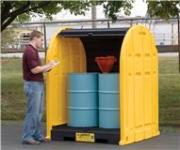
Handling Waste Liquids Carelessly Can Be Expensive
- By Glen Carter
- May 16, 2011
Ignoring the Environmental Protection Agency’s regulations can be costly. In 2010, EPA enforcement actions cost violators more than $110 million in civil penalties. In addition, EPA’s criminal enforcement program saw 198 convicted and $41 million assessed in restitution and fines.
Consider also the potential costs of a fire or explosion when flammable liquids are leaked or spilled. What about remediation and cleanup costs when lakes, rivers or streams are polluted from chemical discharge? Then there is the common fall on floors slippery with pools of spilled liquids. Considering all these risks, compliance with government regulations becomes only one reason to treat hazardous liquids with respect.
The cleanup time of any spill depends on the volume and location of the occurrence, and time spent on cleanup operations is non-productive, resulting in reduced output and lower profits. When injuries occur, costs escalate quickly – a typical minor slip or fall accident requiring medical attention averages about $5,000. Add to this an additional $2,800 for lost time and perhaps six to eight weeks of medical care and treatment, along with a worker’s compensation settlement of $7000, and you will find a what once seemed to be a simple slip quickly adds up to nearly $15,000. For more severe cases, lost time accidents average $40,000.
Even greater are the costs associated with an industrial fire. Just the cost of fighting such a fire can run $100,000 or more. Property damage, the lost time, lost production, human suffering, cleanup, and lost profits all contribute to a staggering bill that must be paid.
Containment is the KeyA drum, tank, or IBC storing hazardous free liquid must be inspected for its integrity on a regular basis. If the container leaks, its contents should be transferred to another container immediately. To prevent the spread of a leaking liquid, every drum, tank, or IBC must rest on some form of “containment system” as required by EPA regulation 40 CFR 264.175:
“Containment.(a) container storage areas must have a containment system that is designed and operated in accordance with paragraph (b) of this section, except as otherwise provided by paragraph(c) of this section. (b) a containment system must be designed and operated as follows: the containment system must have sufficient capacity to contain 10 percent of the volume of containers or the volume of the largest container, whichever is greater. Containers that do not contain free liquids need not be considered in this determination.”
A spill containment pallet is used to store 55 gallon drums that contain hazardous liquids. This type of pallet is designed with a leak-proof sump to capture leaks from a damaged drum or a spill that might occur when filling or pumping out of a drum. The pallet features a removable grate that allows easy access to the sump area so operators can visually check for leaks and clean them up. Containment pallets are offered in two-, three-, or four-drum capacities. Square or space-saving linear styles are available. Every one of these pallets meets the containment standard, with a minimum sump capacity of 66 gallons. Any of them keeps the hazardous liquid from pooling on the floor and ultimately, going down a factory floor drain, protecting against groundwater contamination.
For storage outdoors, weather-resistant drum sheds hold up to four 55-gallon drums. They, too, feature a leak-proof sump with removable grates and meet EPA 40CFR 264.175 for spill control. Safety features include grounding capability, integral anchor bolt locations for wind resistance, and molded-in lugs that accept padlocks for security.
Recycled Plastics Make the DifferenceIn addition, users should be aware of another environmental regulation to consider when specifying spill containment pallets for their facilities:
The SPCC rule is mandated for facilities with 1,320 gallons or more of aboveground storage or 42,000 gallons of buried storage of petroleum oils and non-petroleum oils; animal fats, oils, and greases; fish oils; marine mammal oils; and vegetable oils, including oils from seeds, nuts, fruits, and kernels. The rule outlines the requirement that an owner and operator demonstrate in SPCC plans considerations for secondary containment solutions for containers that are 55 gallons and larger. Each secondary containment must hold the entire capacity of the largest container and have sufficient free board to hold precipitation.
Saving oil, electricity and landfill space are additional objectives to be considered. By specifying spill-control products constructed of recycled polyethylene, you achieve a double-good impact for the environment. Not only do these products protect against groundwater contamination, but their construction materials conserve resources and save landfill space. Well-engineered spill-control equipment made of recycled resin has undergone an extensive review process, and some suppliers have obtained recycled content validation by a recognized third-party auditor, such as UL Environment. This independent validation assures customers that a product that claims to be green really is.
Why is this recycled resin so important? Consider this: One ton of recycled plastic saves: 16.3 barrels of oil, 5,774 kWh of electricity and 30 cubic yards of landfill space. Considering these types of savings, it’s no wonder that the federal government, under President Obama’s executive order 13,514, is required to establish an integrated strategy towards sustainability. EO 13514 requires agencies to ensure that 95 percent of federal purchases, among other initiatives, contain recycled content.
About the Author
Glen Carter is chief technical and application information officer for Justrite Manufacturing.